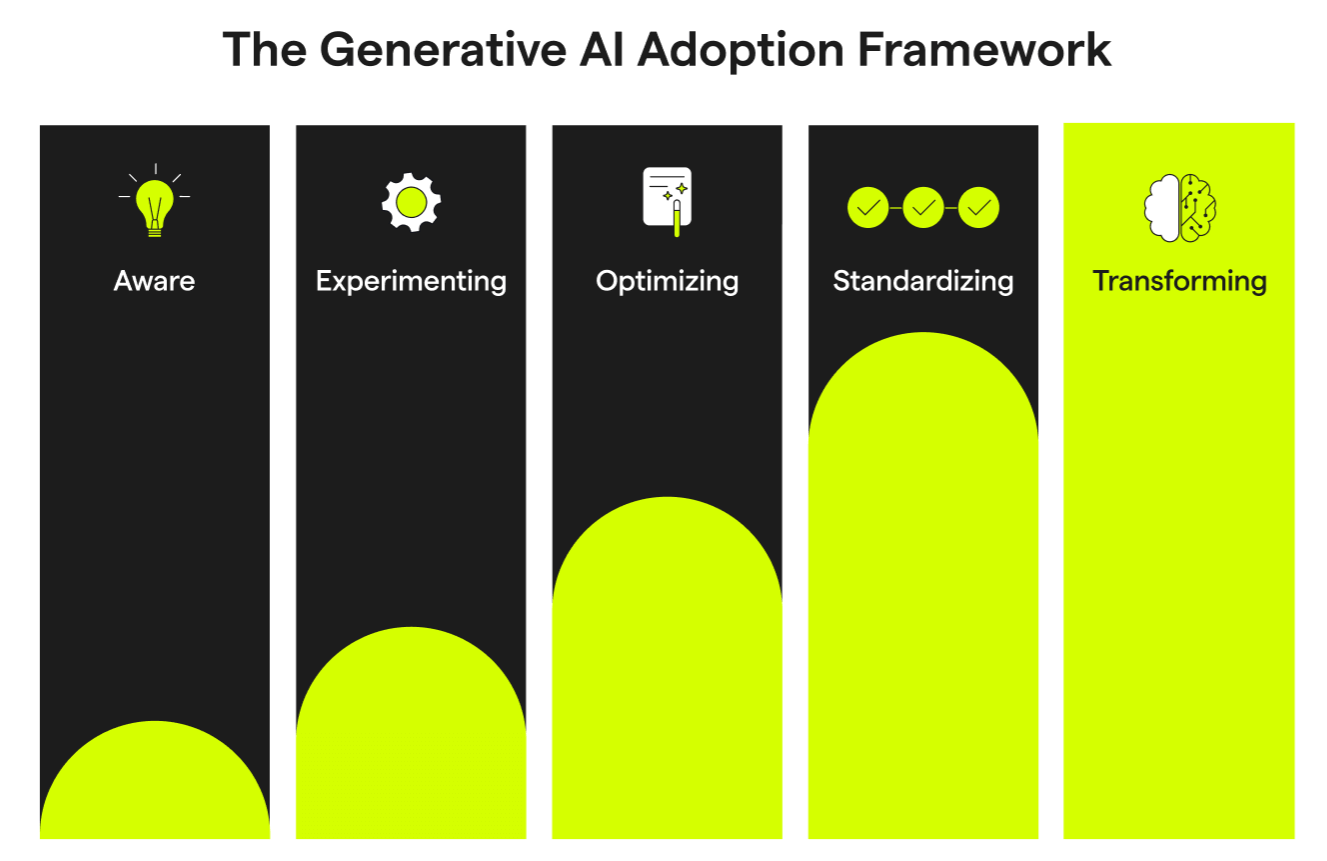Generative AI adoption is reshaping the landscape of technology usage across various sectors. Since the launch of ChatGPT in November 2022, this innovative AI technology has garnered immense popularity, with a significant portion of the population eager to harness its capabilities for enhancing productivity. A recent generative AI survey revealed that nearly 40 percent of Americans have already utilized this technology for tasks both at work and home, marking an exceptional rate of integration compared to previous technological breakthroughs such as personal computers and the internet. As researchers analyze the impact of AI usage demographics, they find that younger individuals, particularly in tech-savvy industries, are leading the charge in embracing generative AI. This rapid adoption signals not only a shift in workplace dynamics but also profound implications for how businesses and individuals alike can leverage AI to optimize their operations and interactions.
The swift integration of advanced artificial intelligence tools into everyday tasks has become a notable trend in recent times. This growing incorporation of creative AI systems, notably seen through the influence of platforms like ChatGPT, highlights a significant change in digital interaction methods. With widespread usage observed in various demographics, particularly among younger professionals, the cultural shift towards employing these innovative technologies for both personal and professional activities reflects a wider acknowledgment of their value. As technology continues to evolve, the understanding and application of generative AI open new avenues for creative content and efficiency, particularly in environments historically reliant on traditional methods. Thus, exploring the dimensions of AI technology acceptance sheds light on the transformative potential that innovative automation brings to the modern workplace.
The Rapid Rise of Generative AI Adoption
The unprecedented speed at which generative AI has been adopted across the United States is astonishing to many experts. With nearly 40% of Americans reporting they have engaged with generative AI technologies, such as ChatGPT, the trend is significantly quicker than the adoption rates for previous innovations like personal computers and the internet. This indicates a marked shift in how individuals are integrating advanced technologies into their daily lives, whether that be in professional tasks or personal endeavors. The ability to produce creative content and streamline tasks through generative AI presents a unique advantage in today’s fast-paced economy.
The impact of this fast-paced adoption is multifaceted. Economists and industry leaders are beginning to investigate not just who is using these technologies but also how they are shaping productivity and operational dynamics within businesses. Almost half of employed individuals using generative AI at work demonstrates a transformative potential that could redefine traditional job descriptions and methods. Companies that leverage this technology effectively stand to gain a significant edge over competitors, making understanding these trends critical for future strategic planning.
AI Technology Usage: A Deep Dive
Exploring the overall usage of AI technologies reveals critical insights into the evolving landscape of the workforce. The results of recent surveys indicate that occupational demographics significantly influence how and when generative AI is utilized. For instance, while younger individuals and those in STEM and management positions demonstrate higher usage rates, other demographic groups also engage with these tools, albeit in varying frequencies. This data highlights the nuanced understanding required to fully grasp the implications of generative AI in different work environments.
Furthermore, as AI technology integrates more deeply into specific industries, the variety of tasks that can be enhanced through generative AI, such as data analysis and content creation, continues to grow. This broad application reinforces the necessity for a diverse skillset among workers and encourages an adaptable workforce to maximize the technological capabilities available. Companies should prioritize training and resources to ensure all employees can maximize their productivity through the effective use of generative AI.
ChatGPT’s Impact on Work and Home Life
ChatGPT and similar generative AI applications are transforming not just workplace dynamics, but also how individuals manage their personal lives. With a significant percentage of users employing these tools outside of their professional environments, it’s clear that generative AI has tapped into a broader vein of consumer need for efficiency and creativity. The promise of generating meaningful content or automating simple tasks has made these technologies an attractive choice for daily functions—from automating chores to assisting in creative pursuits.
As more Americans recognize the utility of ChatGPT, we may see a cultural shift in how technology is perceived in relationship to productivity. The blend of work and home life facilitated by these tools suggests that generative AI is changing the boundaries of professional engagement and personal creativity, suggesting a future where work-life integration is further emphasized by our reliance on technology. Consequently, the challenge will be to find a balance that prevents over-dependence while still utilizing these tools to their fullest potential.
Understanding AI Usage Demographics
The demographics of generative AI usage paint a revealing picture of who is embracing this technology. Not surprisingly, young individuals, those with higher education levels, and employees in tech-heavy roles are leading the charge. This trend reflects broader societal patterns and challenges existing notions about technology adoption. Gender disparities also present a complex narrative; while men often dominate tech fields, women have historically adopted emerging technologies at surprising rates during pivotal shifts, suggesting potential changes in user demographics as generative AI matures.
Moreover, the data indicates a notable divide in acceptance and usage rates across industries, reinforcing the need for targeted outreach and education within organizations. Companies that recognize the varying levels of generative AI engagement among employees will need to develop tailored strategies to encourage its adoption, ultimately fostering a culture that embraces innovation while addressing the concerns of diverse worker profiles.
The Future of Generative AI in Business
As generative AI technologies continue to evolve, businesses must adapt to the impending shifts in how these tools can be effectively used. Early adopters of generative AI often stand to reap the largest rewards, as seen in historical comparisons to the introduction of personal computers and the internet. Companies that invest in harnessing generative AI capabilities now will likely position themselves as frontrunners in innovation, setting industry standards for productivity and creativity.
Moreover, as the survey indicates, there is potential for significant growth in the adoption rates even beyond the current landscape. This compels business leaders to not only track generative AI’s trajectory but to also cultivate environments conducive to experimentation and innovation. By focusing efforts on the integration of generative AI as a staple of operations rather than an optional enhancement, businesses can ensure they remain competitive in an increasingly automated future.
Exploring Generative AI’s Complementary Role
Generative AI is not merely a stand-alone innovation; rather, it serves as a complementary layer built upon foundational technologies such as the internet and personal computers. This synergy is key to understanding why generative AI has experienced such rapid adoption. Many individuals already possess the skills necessary to engage with generative AI effectively due to their previous exposure to computer technology and online interactions.
Given that generative AI enhances existing workflows rather than replaces them completely, businesses can leverage this technology to facilitate the completion of routine tasks. Whether it’s generating content quickly or analyzing large datasets, the potential for efficiency gains is substantial. This does warrant caution, as organizations will need to thoughtfully incorporate generative AI into their day-to-day operations to maintain both productivity and a human touch in their work.
The Role of Education in AI Adoption
As generative AI continues to reshape various sectors, education becomes pivotal in supporting widespread adoption. Institutions and organizations must prioritize educating users about the benefits and limitations of generative AI tools. Understanding how to leverage these technologies for productivity can significantly affect their overall effectiveness in personal and professional settings. Knowledge of how to navigate generative AI will ensure that users can capitalize on its potential without falling prey to over-reliance or misapplication.
Efforts to provide training programs and resources that focus on generative AI capabilities could foster an environment where users feel empowered instead of intimidated. Providing practical examples and hands-on experience can demystify AI technologies, enabling a smoother transition toward more widespread engagement. As workers become more confident in their use of these tools, we are likely to see more innovative applications emerge, further accelerating the integration of generative AI across multiple domains.
Monitoring the Impact of Generative AI Over Time
As generative AI progresses, it is essential to monitor its impact consistently. The nature of its adoption across various demographics and industries offers crucial insights into its development and utilization trends. Regularly updated surveys and research can provide a clearer understanding of how generative AI is changing the workforce, including shifts in attitudes towards technology and varying levels of integration across fields.
The data gathered from ongoing research will be invaluable not only for businesses looking to strategize their future technology investments but also for policymakers aiming to understand and support these changes. As the landscape of work continues to evolve with generative AI, ongoing dialogue and inquiry will be necessary to explore remaining questions and challenges that arise, allowing society to adapt effectively to this new technological era.
Strategies for Businesses to Leverage Generative AI
In an ever-competitive landscape, businesses must develop concrete strategies to leverage generative AI effectively. This involves understanding how generative AI can be integrated into existing workflows to enhance efficiencies. The goal should be to harness the capabilities of generative AI as a means to streamline processes and improve output quality, ultimately translating to better customer experiences and increased profits.
Additionally, organizations should foster a culture of innovation where experimentation with generative AI is encouraged. Promoting an environment that embraces new technologies will allow employees to explore the full potential of generative AI, leading to discoveries that can unlock new avenues for business growth. Continuous learning and adaptation will be key to maximizing the benefits of generative AI in competitive markets.
Frequently Asked Questions
What are the key factors driving the rapid adoption of generative AI technology?
The rapid adoption of generative AI technology is influenced by several factors, including its ability to build upon established technologies like personal computers and the internet. Users are more inclined to embrace generative AI because they are already familiar with these foundational tools. Additionally, the impressive capabilities of generative AI, such as content creation through models like ChatGPT, stimulate widespread interest and practical use across various tasks at both work and home.
How does generative AI adoption differ among various demographics?
Demographic factors significantly impact generative AI adoption rates. Research shows that men, younger individuals, and those with higher education levels tend to use generative AI technology more frequently. Fields such as STEM and management, which often attract a male workforce, also exhibit higher adoption rates compared to blue-collar sectors. Despite these disparities, generative AI usage is found across diverse occupations, indicating its growing integration into various work environments.
What tasks are most commonly associated with generative AI usage in the workplace?
In the workplace, generative AI is primarily used for tasks that involve content generation, such as writing emails, reports, and other documents. It is also utilized for information retrieval, task automation, and enhancing productivity by supporting decision-making processes. This versatility allows employees to apply generative AI in a wide range of job functions, making it a valuable tool across industries.
Is generative AI usage higher at work or at home among users?
According to recent statistics, generative AI usage is nearly balanced between work and home settings. Approximately 28% of employed individuals reported using generative AI technology at work, while around 33% use it for personal tasks at home. This trend indicates that generative AI is increasingly becoming a part of both professional and everyday activities.
What implications does the adoption of generative AI have for future business strategies?
The swift adoption of generative AI signifies a transformative shift in how businesses operate. Companies that capitalize on this technology can gain a competitive advantage by enhancing efficiency and creativity in their processes. As generative AI continues to evolve, organizations need to invest in strategies that integrate this technology effectively, focusing on finding practical applications that can improve their offerings and service delivery.
How does the generative AI adoption rate compare to historical technology adoptions like personal computers and the internet?
Generative AI adoption is outpacing historical technology adoptions, such as personal computers and the internet. Research indicates that nearly 40% of U.S. adults have used generative AI, significantly higher than the 20% adoption rate observed for the internet and PCs at similar points in their technological lifecycle. This rapid uptake suggests that generative AI is poised to become a fundamental tool in both personal and professional settings.
What role does generative AI play in shaping the future of work?
Generative AI is set to play a crucial role in shaping the future of work by automating routine tasks and enhancing creative processes. As businesses increasingly adopt this technology, it will lead to greater efficiency, reduction of repetitive tasks, and the potential for innovation in products and services. This shift may also necessitate a transformation in workforce skills, emphasizing the need for training in AI technologies.
What should businesses do to respond to the growing adoption of generative AI?
Businesses should proactively embrace generative AI technologies by exploring practical applications within their operations. This could involve training employees on AI tools, integrating AI solutions into workflows, and developing innovative strategies that leverage generative AI’s capabilities. Staying ahead of the curve in generative AI adoption will enable companies to enhance productivity, creativity, and competitive positioning in the market.
| Aspect | Key Point |
|---|---|
| Generative AI Adoption Rates | 40% of Americans aged 18-64 have used generative AI, compared to 20% for PCs and the internet at similar developmental stages. |
| Usage at Work vs Home | 28% of employed individuals use generative AI at work; nearly 33% use it outside of work. |
| Demographics | Higher adoption among young people, men, and those with higher education levels. |
| Impact on Occupations | Usage exceeds 20% across most occupations, with the highest rates in STEM and management. |
| Role of Foundational Technologies | Generative AI builds upon the advancements of personal computers and the internet. |
| Future Implications for Businesses | Companies should integrate generative AI into operations to stay competitive in the future. |
Summary
Generative AI adoption is rapidly changing the workplace landscape, as evidenced by a significant percentage of Americans already utilizing these tools. With 40% of adults engaging with generative AI, it is clear that organizations must prioritize the integration of this technology to enhance productivity and remain competitive. This swift acceptance, outpacing the growth of previous technologies, underlines the transformative potential of generative AI in both professional and personal settings. Businesses that adapt and leverage generative AI effectively will not only improve their operational efficiency but can also lead innovation in their industries.


